Funny Viral Videos for Week of October 2018
This is the second iteration of my Top Viral Videos of All Time list, and I didn't realize how challenging it would be to revisit this list.
In just two years, much has changed. The rapid rise of TikTok prompted Instagram to introduce Reels in August 2020, for example. YouTube introduced Shorts in India in September 2020, and in the US in March 2021.
The digital video industry's attention is now stuck on short-form videos — those with a duration from 15 seconds to one minute — instead of the demographics of the audiences on these social video platforms.
Currently:
- 25% of TikTok users are 10-19, 22.4% are 20-29, and 21.7% are 30-39.
- 22.9% of Instagram users are 18-24 and 31.5% are 25-34.
- 77% of YouTube users are 15-25 and 77% are 26-35.
In addition, 72.6% of YouTube's user base is male, while 56.5% of Instagram's and 61% of TikTok's user base is female.
So, should you focus on the platform that your target audience prefers or the content that speaks to what they're passionate about?
The Viral Video Landscape is Changing
Connected TV was the fastest-growing screen among YouTube viewers in 2020.
In fact, Tara Walpert Levy reported recently that over 120 million Americans streamed YouTube or YouTube TV on their TV screens in December 2020.
And increasingly, people are choosing to watch their favorite content with others.
According to Talk Shoppe, 57% of Americans say they watch YouTube videos on TV screens with others. So, this new screen could become an even bigger game-changer than the advent of mobile devices was a decade ago.
On the other hand, some changes have been more evolutionary.
Two years ago, 23 out of the top 25 videos with the most views of all time were music videos, with "Luis Fonsi – Despacito ft. Daddy Yankee" at the top of the list with 6.1 billion views.
Today, if I selected the top 40 videos with the most views of all time, all you would see is a list of YouTube videos consisting of a mix of children's content, like this Baby Shark video with 8.8 billion views.
I still think that "views" is not an accurate measure of "virality," at least not by itself.
For example, YouTube says a "view" is counted when someone watches 30 seconds of your video ad (or the duration if it's shorter than 30 seconds) or interacts with the ad, whichever comes first.
Facebook and Instagram say a "view" is counted after someone watches just 3 seconds of a video of any length.
And TikTok says a "view" is counted as soon as the video starts playing in someone's feed.
That's why the Global Video Measurement Alliance says, "View count doesn't cut it anymore."
Plus, views can be bought.
Now, I'm not talking about illicitly purchasing views from a third party to artificially inflate your view count. I'm talking about using advertising to promote your content.
Hey, this second option is perfectly legit – in fact, YouTube and Facebook encourage it in order to make sure your target audience sees your videos.
In July 2006, 63 million people worldwide visited YouTube.com, according to the first comScore data published about the video-sharing site. Today, over 2 billion logged-in users visit YouTube each month.
So, any list of the top viral videos of "all time" is going to be heavily tilted in favor of videos that were uploaded in more recent years.
That's why my list below of the top 40 viral videos of all time excludes children's content as well as major label music videos.
My list also uses engagements – a combination of likes, shares, and comments – as well as views to ensure that videos have "gone viral" the old-fashioned way: They earned it.
Finally, the very first video, "Me at the zoo," was published on May 29, 2005.
I've chosen that as my starting point and then selected two or three of the top viral videos from each of the succeeding years to give content creators and video marketers an idea of how the process of "going viral" has mutated over time.
Hopefully, this will provide you with 40 useful, valuable, and practical lessons that you can apply this month, this week, or tomorrow in your own video marketing strategy.
Year 1: May 29, 2005 to May 28, 2006
One of the first viral videos that helped to put YouTube on the map was Lazy Sunday.
Uploaded in December 2005, it was a bootleg copy of the Saturday Night Live skit, The Chronicles of Narnia Rap.
So, how popular was this video?
Well, David Itzkoff of The New York Times reported back then that Lazy Sunday racked up 1.2 million views in its first 10 days.
And LeeAnn Prescott of Hitwise reported in December 2005 that visits to YouTube had shot up 83% since the video had been uploaded – and had passed visits to Google Video. (And the rest is history.)
By the end of January 2006, Prescott reported, "Since my post last month on YouTube and the SNL Chronicles of Narnia rap, YouTube has continued to gain market share against other video search sites, and since surpassing Google Video, it has also surpassed Yahoo! Video Search."
Then, Lazy Sunday was removed from the video-sharing site in February 2006.
In a post on the YouTube blog, the YouTube staff explained: "NBC recently contacted YouTube and asked us to remove Saturday Night Live's Lazy Sunday: Chronicles of Narnia video.
We know how popular that video is but YouTube respects the right of copyright holders. You can still watch SNL's Lazy Sunday video for free on NBC's website."
Ironically, Saturday Night Live re-uploaded Lazy Sunday to its YouTube channel in August 2013, seven-and-a-half years after it was removed.
Why did they do that and what lesson can you learn from this? Well, copyright owners can monetize their videos on YouTube.
Yes, they have to split their ad revenue with YouTube. But, it seems reasonable to assume that someone at NBC finally figured out that SNL could make more money by letting advertisers run ads against Lazy Sunday on YouTube as well as on NBC's website than they would get by continuing to hoard their video content on their own site, which gets significantly less traffic.
Another video that went viral in YouTube's first year was Evolution of Dance. Uploaded by Judson Laipply in April 2006, it has 309 million views and 1.6 million engagements, according to Tubular Labs data.
Now, it should have even more views and engagements, but this video was blocked in the U.S. for several years on copyright grounds because it contains content from Warner Music Group (WMG).
So, why did they do that and what lesson can you learn from this?
Well, using YouTube's Content ID system, copyright owners can choose to monetize a video and share revenue with the uploader. Or, they can block a whole video from being viewed.
So, WMG didn't seem to want to share squat with Laipply for a number of years.
But, then the multinational entertainment and record label conglomerate either decided that some revenue was better than none or suddenly started to care what I had written two years ago when I discovered that Evolution of Dance had been blocked.
In either case, don't assume that you can freely sample a song under the "fair use" principle. And if you want to include some music or sound effects in your videos, without having to negotiate licenses with each copyright owner, then use the YouTube Audio Library to find high-quality audio tracks, which are royalty-free.
Year 2: May 29, 2006 to May 28, 2007
One of the top viral videos from YouTube's second year was ' Chocolate Rain' Original Song by Tay Zonday. Uploaded in April 2007, it has 130 million views and 1.7 million engagements.
Here's the backstory. The video was originally posted on 4chan.org, where Zonday's breathe-away-from-the-mic move was mocked and tons of parody videos were made in response.
But, Chocolate Rain didn't go viral until July 2007, when YouTube simultaneously featured all of the parody and response videos on its home page.
Okay, what lessons can we learn from this viral video with its unconventional lyrics and delivery?
Well, even if you are mocked by the self-appointed trend-setters, you can still get the last laugh when you are invited on Jimmy Kimmel Live and then go on to get "paid a hefty, hefty fee" when your video becomes part of a promotional campaign for Cherry Chocolate Diet Dr. Pepper.
One of the other top viral videos from YouTube's second year is Charlie bit my finger – again!
Uploaded in May 2007, it has 886 million views and 2.7 million engagements.
Howard Davies-Carr, Harry and Charlie's father, lives in the U.K. He uploaded the video to YouTube so that it could be watched by the boys' grandfather, who was living in the U.S.
After it inadvertently went viral, he chose to monetize the video by allowing ads to run next to it. In 2011, it was reported that the Davies-Carr family had made over £100,000 in advertising revenue from the video.
The money from the viral video was enough to enable the family to purchase a new house.
And here's the latest update: An NFT of the "Charlie bit me" meme was just auctioned off on May 23, 2021, for $760,999.
So, the viral video may soon be deleted, which would "really hurt" anyone who wants to learn lessons from history more than Charlie's bite "really hurt" Harry's finger.
Year 3: May 29, 2007 to May 28, 2008
A couple of funny cat videos went viral during YouTube's third year, giving the video-sharing site an undeserved reputation that it is still trying to overcome today.
One of these was Charlie Schmidt's Keyboard Cat! – THE ORIGINAL!
This video was uploaded in June 2007 and has 62.5 million views and 1.1 million engagements.
This video features a tabby, which appears to play a tune on a keyboard. Now, seen on its own, it makes very little sense.
But when technical editor Brad O'Farrell found the footage and placed it at the end of another video, it spread like wildfire.
"Play him off, Keyboard Cat" became a way to signal it was time to wrap it up after an awkward situation or slip-and-fall blooper.
Keyboard Cat mashups added a touch more absurdity to already absurd situations, like a man falling off a treadmill or Miss Teen South Carolina flubbing her geography.
Combine that with the Internet's penchant for cats, and a craze is born.
However, other videos in different genres were also going viral during this time period.
This includes LEAVE BRITNEY ALONE! by Chris Crocker, which got 50.7 million views and 657,000 engagements.
The video is now unavailable because Crocker closed his YouTube account in September 2015.
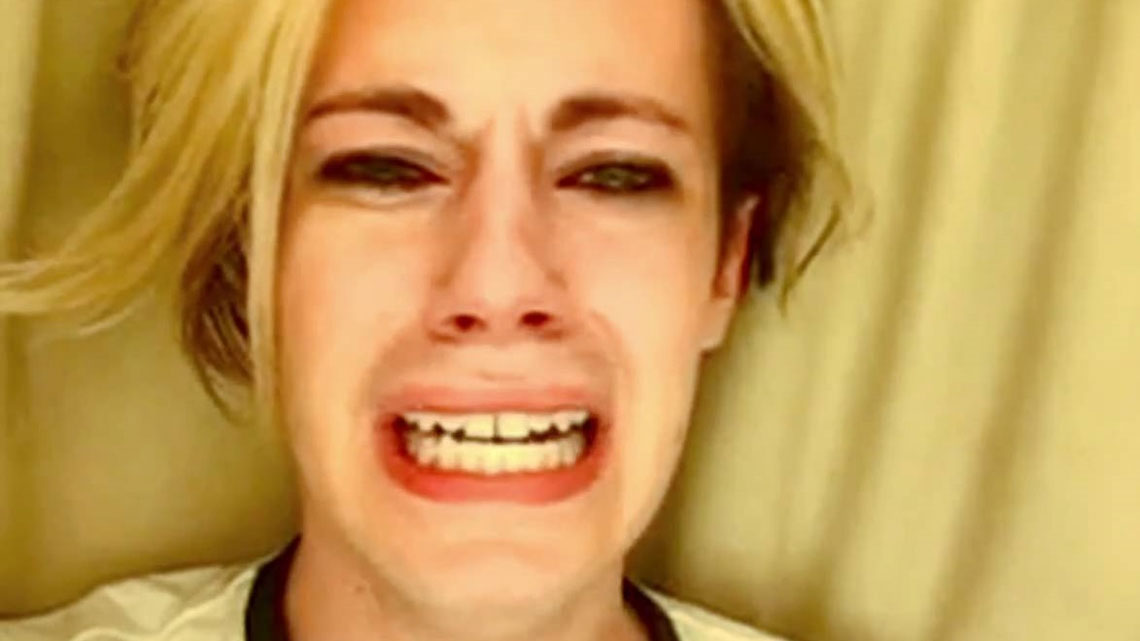
Many people mistakenly think that the only videos that go viral are ones featuring animals, babies, and dancing. Well, this isn't necessarily true.
Year 4: May 29, 2008 to May 28, 2009
Now, I recognize that my next example features a cute kid, which undercuts the assertion that I've just made.
Nevertheless, David After Dentist is still worth including in my list of the top viral videos of all time.
Uploaded in January 2009, it has 140 million views and 547,000 engagements.
And what's the backstory? Well, David DeVore Sr. took the video of his son, David Jr., in May 2008. For the next seven months, he only shared the video with family and friends. Then he uploaded it to YouTube to make it easier to share.
David Sr. has said, "Due to the limit YouTube has for the number of emails you can send the link to for private sharing, I chose to make it public thinking no one would think it was as funny as we did. Shows you what I know."
The video went viral and the DeVore family was soon invited to join the YouTube Partner Program, which enabled them to monetize "David After Dentist."
According to Time, "…it's paying off: the DeVores have made nearly enough to cover David's (eventual) college education."
What lessons does this teach marketers?
First, slice-of-life videos can go viral. Who wouldn't share a video that features a kid who asks, "Is this real life?"
Second, if YouTube invites you to include one of your more unforgettable videos in its Individual Video Program, just say, "Yes."
Now, let me share a powerful example of a viral video from YouTube's fourth year that doesn't include funny cats, cute kids, or old dance moves: Susan Boyle – Singer – Britain's Got Talent 2009.
Uploaded in April 2009, this video had 96 million views as of August 2010, when the clip was removed from Britain's Got Talent channel due to a copyright claim by Alain Boublil Music Ltd.
However, there are still copies on YouTube. This includes Susan Boyle – Britains Got Talent 2009 Episode 1 – Saturday 11th April | HD High Quality, which has 252 million views and 1.1 million engagements.
So, what's the lesson in viral videos featuring Susan Boyle?
Dr. Karen Nelson-Field conducted rigorous research on this topic at the University of South Australia's Ehrenberg-Bass Institute for Marketing Science. And she published her findings in "Viral Marketing: The Science of Sharing."
Nelson-Field reported, "When a video included a creative story of personal triumph, it was shared more than other creative devices" (including baby/young child, animal, and dancing/singing)…
She added, "Interestingly, despite being a more applicable creative device for ensuring sharing success, personal triumph is rarely displayed in viral video content. In our sample of 800 videos, it appeared in less than 3 percent of all videos."
She concluded, "Personal triumph, therefore, represents the best opportunity for marketers."
Year 5: May 29, 2009 to May 28, 2010
In YouTube's fifth year, one of the more memorable viral videos was JK Wedding Entrance Dance.
Uploaded in July 2009, it has 102 million views and 510,000 engagements.
Okay, so this video features dancing. And, the next one includes a man on a horse, which is an animal.
Of course, I'm talking about Old Spice | The Man Your Man Could Smell Like. Uploaded in February 2010, it has 59.7 million views and 261,000 engagements.
Now, maybe I don't need to point out the obvious, but this viral video is an ad.
In fact, it was part of a campaign that consisted of eight YouTube videos, which tallied a total of 98.7 million views and 337,000 engagements.
And the campaign was for an everyday hygiene item, so who would have guessed that it would go viral?
But, that's not all. In July 2010, Noreen O'Leary and Todd Wasserman of Adweek reported that monthly sales of Old Spice Body Wash had increased 107% after the campaign.
So, are there any other lessons to learn? Well, this viral video features a "talking head."
That's the derogatory term given to TV commercials that consist of a pitchman extolling the virtues of a product. Now, many agency people argue that talking heads aren't "creative."
But, as David Ogilvy said in his classic book, Ogilvy on Advertising, "When I write an advertisement, I don't want you to tell me that you find it 'creative.' I want you to find it so interesting that you buy the product." Amen.
Year 6: May 29, 2010 to May 28, 2011
Another viral video that doesn't feature animals, babies, or dancing is the BED INTRUDER SONG!!!
Uploaded in July 2010 by Schmoyoho, it has 150 million views and 1.3 million engagements.
What can marketers learn from the most-watched video of 2010? Well, the Gregory Brothers took the quirky television interview that Antoine Dodson gave after his sister's attempted assault and turned it into a chart-topper for Auto-Tune the News.
The next viral video features singing. It's Rebecca Black – Friday.
Originally uploaded in March 2011 to Ark Music Factory's channel, that version got more than 166 million views before it was removed from YouTube in June 2011 due to legal disputes between ARK Music and Black.
However, the "official version" that was uploaded to Rebecca's channel in September 2011 has 153 million views and 2.2 million engagements.
So, what's the backstory on this video? Well, it didn't go viral in March until sites like BuzzFeed and Reddit posted it as "the worst song ever."
That's right, Rebecca Black's pop anthem went viral solely because people were making fun of her.
But Jeremy Scott, the co-founder of CinemaSins, thinks we all got trolled hard.
In March 2011, he wrote in Tubular Insights, "We've been set up and manipulated – played like a second-hand guitar. Not by Black, mind you – I remain fairly convinced that she's just a normal 13-year-old. I think the real puppet master here is Ark Music Factory."
He added, "Ark Music Factory is the company that produced the video, and I think they made this whole thing happen. To be clear: I think they knew the song was bad… I think they uploaded it anyway… and I think they set about using social bookmarking and social media sites to specifically gain the video some views based on its poor quality."
Now, he admitted at the time, "I don't have any proof… obviously. But I do have plenty of red flags and circumstantial evidence."
This included:
- The video was initially on Ark Music Factory's channel, not Rebecca Black's.
- This video was picked by the Internet as the one to mock on the same day.
- Ark's website had banner ads to buy their artists' songs on iTunes.
- People often game curated sites for marketing purposes.
So, what lessons can you learn from this?
Well, there are 5,542 parodies and remixes of Rebecca Black's "Friday" on YouTube with a total of 815 million views and 9.8 million engagements.
So, even if you're skeptical of Scott's theory, you should still carefully consider his conclusion: "The adage that 'there's no such thing as bad publicity' has never been more true than it is today… If you think marketing companies aren't savvy enough to know that and attempt to capitalize on it – even to the point of mocking the thing they're charged with promoting – then you're pretty naive."
Year 7: May 29, 2011 to May 28, 2012
Now, the next viral video from YouTube's seventh year was made by a little-known non-profit. It's KONY 2012.
Uploaded in March 2012, it has 103 million views and 1.8 million engagements. (This video is age-restricted and only available on YouTube.)
The incredible success of this 30-minute video demonstrates how a relatively unknown entity can still make a global impact in social media with powerful content and a savvy marketing strategy.
What lessons can you learn from its success?
In July 2007, Mary Madden, a Senior Research Specialist for the Pew Internet & American Life Project, had said, "Young adults are the most 'contagious carriers' in the viral spread of online video."
And in March 2012, a new report on the viral KONY 2012 video by Lee Rainie, Paul Hitlin, Mark Jurkowitz, Michael Dimock, and Shawn Neidorf for the Pew Research Center found the same pattern.
According to Pew's report, those 18 to 29 years old were much more likely than older adults to have heard a lot about the KONY 2012 video. And they were also much more likely than older adults to have learned about it through social media, rather than traditional news sources.
In addition, younger adults were more than twice as likely as older adults to have watched the video itself on YouTube or Vimeo. So, this should be your target audience, too.
In May 2012, Uncle Drew | Chapter 1 | Pepsi Max went viral. Featuring Kyrie Irving in disguise, this video got 57.7 million views and 239,000 engagements.
Now, this video doesn't look like an ad, does it? And according to the video's description, "Pepsi MAX went to a pick-up game in Bloomfield, NJ, pretending to shoot a documentary on a basketball player named 'Kevin.' When his Uncle Drew came into the game, some magical things happened."
And even if you aren't a Brooklyn Nets fan, you can learn some useful, valuable, and practical lessons about creating a parody/comedy skit/prank that goes viral just by watching Uncle Drew.
Year 8: May 29, 2012 to May 28, 2013
Now, I realize that you probably think I'm excluding all music videos from this list, but if you go back and re-read what I actually said, it only "excludes major label music videos."
Why am I quibbling over what's excluded?
Because I really, really wanted to include the next viral video in this list. It's PSY – GANGNAM STYLE ( 강남스타일) M/V.
Uploaded in July 2012, it has 4.1 billion views and 27.2 million engagements.
As Kevin Allocca, YouTube trends manager, said in a post on the Official YouTube Blog, "This year, Korean Pop music transcended boundaries and took the world by storm."
And as Chris Atkinson added in a post on Tubular Insights, "This is a gigantic breakaway hit because, yes, the song is catchy, but the video has everything you want: lunacy, hot girls, and a funky dance."
On the other hand, Dove Real Beauty Sketches | You're more beautiful than you think (3mins) doesn't feature a funky dance.
This enlightening video went viral in April 2013 and has 69.6 million views and 189,000 engagements.
As the video's description says, "In one of the most famous Dove films, Real Beauty Sketches explores the gap between how others perceive us and how we perceive ourselves. Each woman is the subject of two portraits drawn by FBI-trained forensic artist Gil Zamora: one based on her own description, and the other using a stranger's observations. The results are surprising…"
Why did this video go viral?
Well, Susan Wojcicki, the CEO of YouTube, wrote an op-ed in Adweek that said,
"These video ads don't just generate impressions, they leave impressions. Women ages 18-34 are twice as likely to think highly of a brand that made an empowering ad and nearly 80 percent more likely to like, share, comment, and subscribe after watching one. We also ran ad recall studies on eight of the campaigns on the Empowering Ads Leaderboard, and all performed in the top 25 percent of their categories, with most in the top 10 percent."
Wojcicki also asked, "So, if empowering ads are so effective, why are we only seeing them now?"
She said,
"Partly because women are being called upon to advertise to women. Despite the disappointing fact that only 11 percent of creative directors are women, half of the creatives responsible for the empowering ads on our Leaderboard were women. With women expected to control two-thirds of consumer spending in the U.S. over the next decade, creative agencies would be wise to empower women not just in their video ads but in their own ranks."
Year 9: May 29, 2013 to May 28, 2014
Here's another music video that wasn't created by a major label. It's Ylvis – The Fox (What Does The Fox Say?) [Official music video HD].
Uploaded in September 2013, it has 1 billion views and 8.8 million engagements.
Now, if I need to defend my inclusion of this music video, then I can point to Allocca's post on the Official YouTube Blog, which listed "What Does The Fox Say?" as the top Trending Videos for 2013 instead of one of the Top Music Videos for the year.
Why did this video go viral? Well, it features music that kids might like, people dressed in animal costumes, and lots of funky dancing. But, maybe that's just a strange coincidence.
On the other hand, two other viral videos from YouTube's ninth year don't feature any of that.
The first is GoPro: Backflip Over 72ft Canyon – Kelly McGarry Red Bull Rampage 2013. Uploaded to the GoPro channel on YouTube Oct. 22, 2013, this sports video shows Kelly McGarry flips a 72-foot-long canyon gap at Red Bull Rampage 2013 to earn 2nd place.
The video has 208 million views and 2.4 million engagements.
The second is FIRST KISS. As the video's description says, "We asked 20 strangers to kiss for the first time…"
Uploaded in March 2014, it got 149 million views and 666,000 engagements.
Here's the backstory: WREN, a relatively unknown brand outside of fashion circles, took the industry by storm, and showed how a small brand with limited resources could create one of the most talked-about marketing campaigns of the year.
Just a month after its release, First Kiss had increased website traffic by 14,000% and sales by 13,600 percent.
Not bad. Not bad at all.
Year 10: May 29, 2014 to May 28, 2015
One of the viral videos from YouTube's tenth year is Always #LikeAGirl.
Uploaded in June 2014, it got 69.7 million views and 382,000 engagements.
As the video's description says, "Using #LikeAGirl as an insult is a hard knock against any adolescent girl. And since the rest of puberty's really no picnic either, it's easy to see what a huge impact it can have on a girl's self-confidence."
The description also quotes Lauren Greenfield, the filmmaker, and director of the #LikeAGirl video. She says, "In my work as a documentarian, I have witnessed the confidence crisis among girls and the negative impact of stereotypes first-hand."
She adds, "When the words 'like a girl' are used to mean something bad, it is profoundly disempowering…. I am excited to be a part of the movement to redefine 'like a girl into a positive affirmation."
But, July and August of 2014 will long be remembered for the Ice Bucket Challenge, which involved pouring a bucket of ice water over your head to promote awareness of ALS, also known as Lou Gehrig's disease, and to encourage donations to research.
One of the videos that went viral was Bill Gates ALS Ice Bucket Challenge. It's worth noting that Gates accepted Mark Zuckerberg's ALS Ice Bucket Challenge.
Uploaded to the Bill Gates channel on YouTube on Aug 15, 2014, the video got 37.1 million views and 800,000 engagements.
It's also worth noting that the Ice Bucket Challenge raised over $220 million worldwide.
Another video that went viral during YouTube's tenth year is 10 Hours of Walking in NYC as a Woman.
Uploaded in October 2014 by Rob Bliss Creative, a viral video agency, it has 50.4 million views and 161,000 engagements.
This viral video also generated 448 response videos, which got a total of 215 million views and 2.5 million engagements.
This included 10 Hours of Walking in NYC as a Woman in Hijab, which got 18.9 million views and 238,000 engagements. And, as we've all been told, imitation is the sincerest form of flattery.
Year 11: May 29, 2015 to May 28, 2016
In YouTube's eleventh year, it's worth noting that one of the videos that went viral was YouTube Rewind: Now Watch Me 2015 | #YouTubeRewind.
Celebrating the videos, people, music, and moves that made 2015 memorable, the video featured 89 YouTube stars. (Blinding flash of the obvious: This is a sure-fire way to help a video go viral.)
It got 154 million views and 3.4 million engagements.
And now for something completely different.
Who would have guessed that one of the videos that went viral during this year would be ' Obama out:' President Barack Obama's hilarious final White House correspondents' dinner speech.
And who would have guessed that it would have been uploaded by Global News in April 2015 and go on to get 50.8 million views and 566,000 engagements?
Here's the backstory: As President Obama was getting set to leave office, he didn't hold back in his final speech at the White House correspondents' dinner, firing barbs at himself, Donald Trump, Hillary Clinton, Ted Cruz, Bernie Sanders, and Justin Trudeau.
Obama said, "If this material works well, I'm going to use it at Goldman Sachs next year. Earn me some serious Tubman's."
Hey, there are lots of lessons that content creators and video marketers can learn from this guy. Obama's 2008 presidential campaign team was named #1 in the Fast Company 50.
The magazine said, "This year's most successful startup took a skinny kid with a funny name and turned him into the most powerful new national brand in a generation."
Fast Company added, "The team has become the envy of marketers both in and out of politics for proving, among other things, just how effective digital initiatives can be."
Another video that went viral the following month has changed the viral video landscape as we know it. Uploaded by Candace Payne to her Facebook page in May 2016, the video was initially called, "It's the simple joys in life…" There, it got 180 million views and 2.9 million engagements.
Then, a version was uploaded to YouTube, where it was named, LAUGHING CHEWBACCA MASK LADY (FULL VIDEO). There, it got 13 million views and 158,000 engagements.
Altogether, 1,561 videos of the "Chewbacca Mask" woman or lady were uploaded to YouTube (678), Facebook (458), Instagram (307), Twitter (117), and Twitch (1).
They got a total of more than 200 million views and over 4.7 million engagements. But, the lion's share of both views and engagements were on Facebook, not YouTube.
And, what lesson can literally everyone in the social video industry learn from that?
Well, shortly after Payne's video went viral, Facebook started making moves to become "video first" in July 2016, according to USA Today.
And shortly after that, Mark Zuckerberg started talking up Facebook's "video first" strategy in November of that year, according to USA Today.
The process of going viral started mutating in unexpected directions. Coincidence? I think not.
Year 12: May 29, 2016 to May 28, 2017
Up to this point in time, YouTube content creators had relied on their imagination to create great content that might unexpectedly get an intense psychological response like happiness, exhilaration, amazement, inspiration, hilarity, warmth, or surprise. They wanted to trigger viewer motivation to not only watch but also to like, comment on, and share their video.
A good example is Samsung India Service (SVC) – Most Watched Video in 2017 – We'll take care of you, wherever you are.
The video's description says, "This video shows a story of how a young Samsung Engineer undaunted by rough terrain, attends to a customer complaint in a remote hilly area. His efforts help bring up smiles on the faces of a group of children, for whom their Samsung Television is the medium to celebrate their special moment."
Uploaded to the Samsung India channel on Dec. 30, 2016, this four-minute-long video has 212 million views and 217,000 engagements.
From this point on, many (but not all) YouTube content creators could also leverage the large base of subscribers that many (but not all) YouTube influencers had built over the years.
They could borrow a page out of the YouTube creator playbook, which shared the know-how developed by a generation of YouTube content creators to develop content strategies that would resonate with 21st-century consumers.
And up to this point in time, YouTube content creators had relied on advertising to monetize their views and engagements – earning five figures per year at first and then six figures per year on YouTube.
But, from this point on, many (but not all) YouTube influencers started creating sponsored videos for brands, often making a lot more money.
For example, check out Ping Pong Trick Shots 3 | Dude Perfect.
Uploaded to Dude Perfect's YouTube channel in April 2017, which has 56.2 million subscribers, this sponsored video for Oreo got 308 million views and 7 million engagements.
Up to this point in time, viral videos had been uploaded to YouTube first and then shared to Facebook and other social media.
But from this point on, many (but not all) videos that went viral started being uploaded to both platforms simultaneously.
And up to this point in time, many viral videos had featured personal triumph, a baby/young child, a parody/comedy skit/prank, dancing/singing, an animal, or some other creative device.
But from this point on, many (but not all) videos could go viral by providing useful, valuable, and practical tips, tricks, and hacks.
For example, check out Get clever with your clutter…and these 7 organization hacks!
Uploaded to Blossom's Facebook page in May 2017, which has 56.5 million subscribers, it got 451 million views and 16 million engagements.
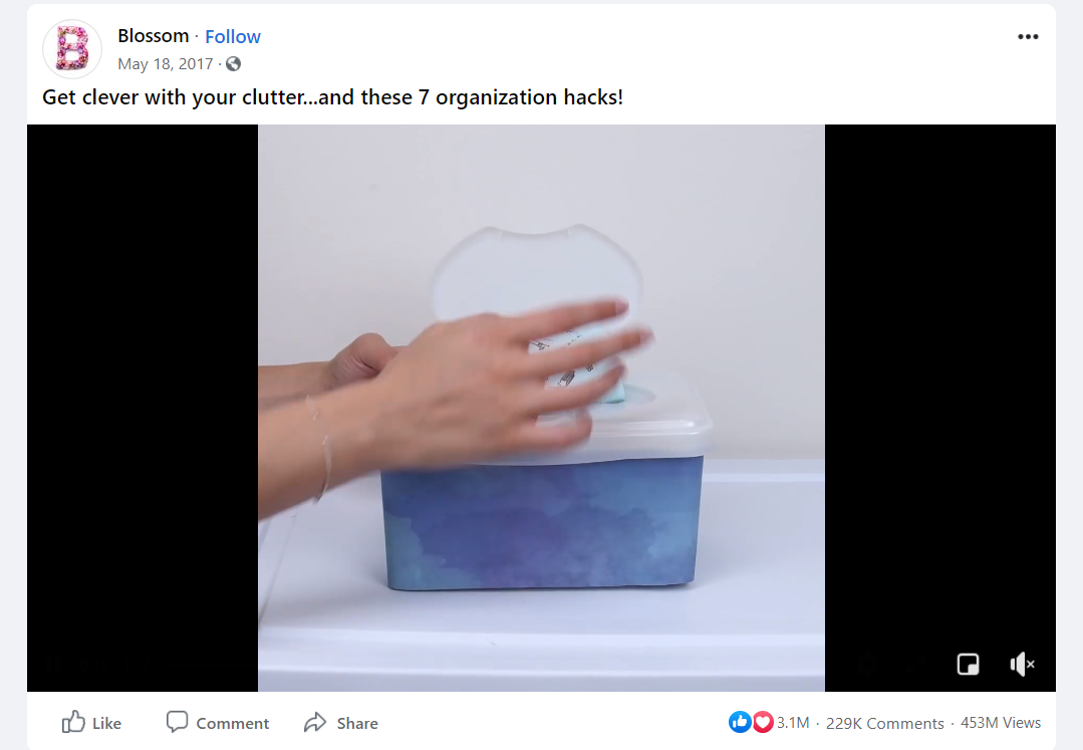
Year 13: May 29, 2017 to May 28, 2018
The need to build a large base of subscribers in order to increase the odds of having your videos "go viral" has prompted some (but not many) brands to start acting as if they were media companies.
Instead of creating "hero" content once or twice a year, they started creating "hub" content once or twice a week.
What's "hero" content?
Well, it's the kind of content that you want to push to a big, broad audience. You know, your Super Bowl moment. A brand might have only one hero moment in a year, such as a product launch or an industry tent-pole event.
For example, YouTube continues to create hero content because it continues to work.
YouTube Rewind: The Shape of 2017 | #YouTubeRewind celebrated the videos, people, music, and memes that made 2017 memorable.
So many content creators were featured in the video that the description couldn't include all their names. The video got 238 million views and 5.6 million engagements.
Hub content, on the other hand, is the kind of content that you develop on a regular basis to give a fresh perspective on your target's passion points. This content is uploaded once or twice a week.
For example, check out Door in the Sky. Uploaded to Red Bull's Facebook page in November 2017, which has 49 million subscribers, it got 264 million views and 5.7 million engagements.
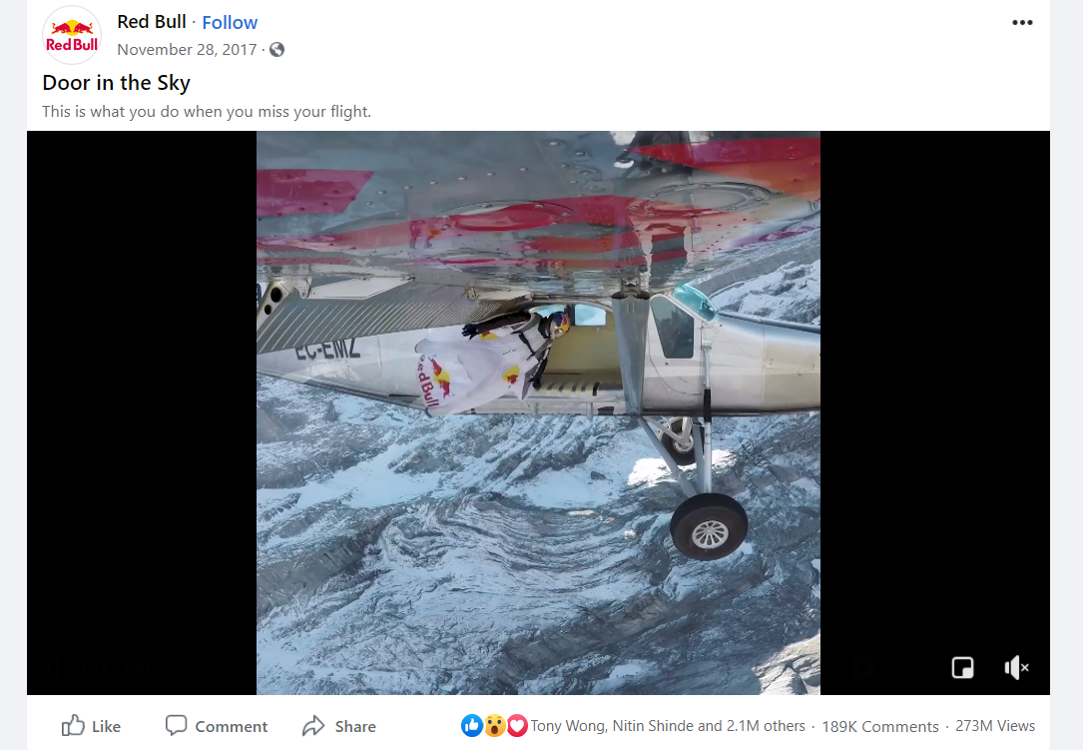
But, that's just the tip of the iceberg.
Red Bull uploaded 2,484 videos to its Facebook page from May 29, 2017, to May 28, 2018.
It also uploaded 1,883 videos to its Instagram account and another 581 videos to its YouTube channel during that period.
And these 5,302 videos got a combined total of more than 3.5 billion views (that's billion with a "b") and 158.8 million engagements over 365 days.
And 106 of these videos got more than a million views and 100,000 engagements.
These are viral videos by anyone's definition. And, on average, Red Bull is creating more than two of them a week.
Want an Instagram example of hub content? Then, check out @kingjames takes it and wins it with the Tissot Buzzer Beater! #ThisIsYourTime.
Uploaded to the NBA's Instagram account in May 2018, which has 35.2 million subscribers, this sponsored video for luxury watch brand Tissotgot 3.9 million views and 807,000 engagements.

But, we're just scratching the surface. The NBA uploaded 133 sponsored videos to Instagram from May 29, 2017 to May 28, 2018.
It also uploaded 170 sponsored videos to Facebook and two sponsored videos to YouTube, which earned 267.4 million views and 29.9 million engagements over 365 days.
Just 112 of these sponsored videos got more than a million views and 100,000 engagements. So, these are also viral videos by the definition that we've been using.
On average, the NBA is creating more than two of them a week. And if you consider that the regular season begins in late October and the playoffs end in early June, then the NBA's sponsored videos are going viral about three to four times a week when basketball games are actually being played.
Year 14: May 29, 2018 to May 28, 2019
This brings us to the final year that I wrote about two years ago. In my earlier article, I asked a rhetorical question: "Do you really need your videos to go viral in order in order to generate results these days?"
With 20/20 hindsight, I would like to ask for a mulligan. It turns out that rumors of the death of viral videos were greatly exaggerated.
For example, many industry observers – including me – mistakenly thought that the so-called Facebook Apocalypse of January 2018 signaled the death of viral videos on that platform.
Hey, even Adam Mosseri, who was then the Head of News Feed for Facebook, said at the time, "Because space in News Feed is limited, showing more posts from friends and family and updates that spark conversation means we'll show less public content, including videos and other posts from publishers or businesses."
But, despite the apocalyptic prognostications of industry observers, 10 tricks you didn't know you could do with your food!, which was uploaded to Blossom's Facebook page on Sept. 18, 2018, still managed to get 489 million views and 10.4 million engagements.
Although this content is no longer available, MetDaan Fashion posted a video entitled, 10 tricks you didn't know you could do with your food! , to Facebook on April 9, 2021.
So, you can get an idea of why this genre of content went viral.
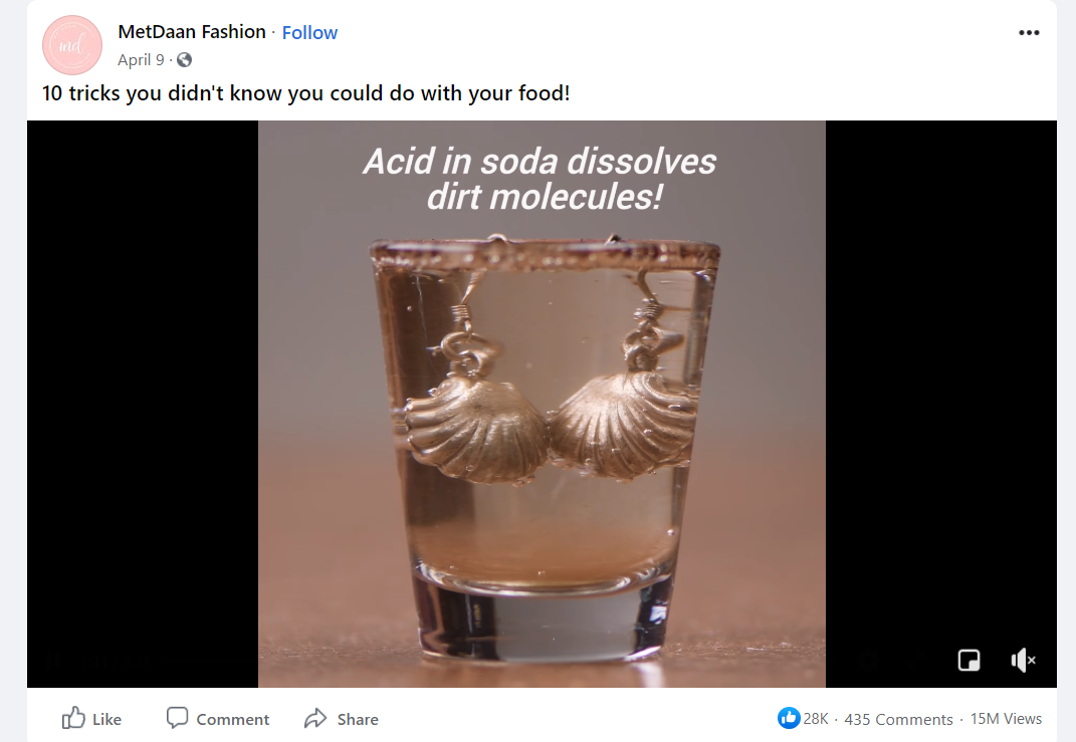
Meanwhile, 2019 turned out to be the breakout year for TikTok. For example, on Feb. 19, 2019, Caleb Cutler uploaded "Food Surgery" to his TikTok account.
His video about surgery on a banana went viral and got 6.5 million likes.
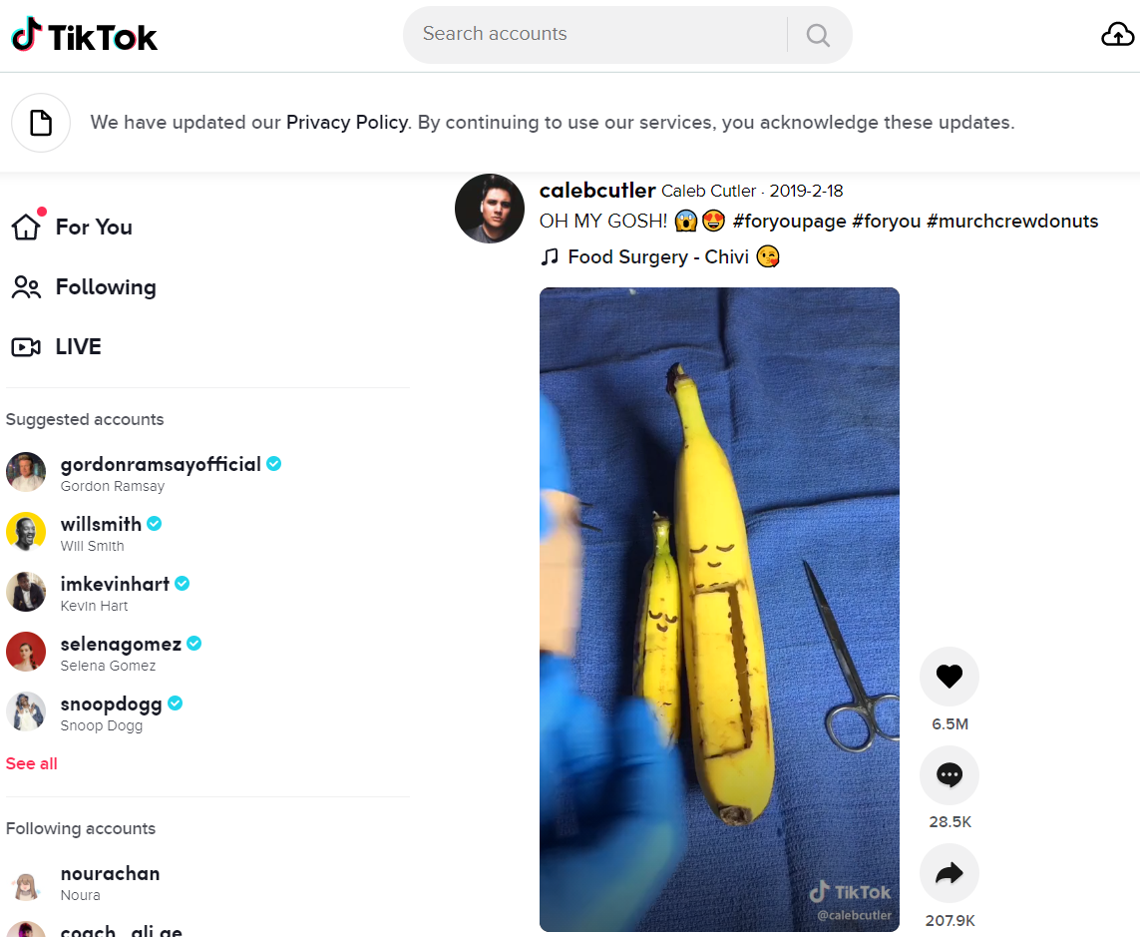
Meanwhile, the most liked creator video of the year on YouTube was aptly titled, Make This Video The Most Liked Video On YouTube.
Uploaded by MrBeast on Jan. 16, 2019, it has 90.6 million views and 18.4 million engagements.
Now, if you think that TikTok has forced me to change my ranking criteria, then you're right.
The (global) ranking of this collective endeavor to create the most liked video on YouTube is based on "likes" of videos uploaded in 2019, excluding videos from artists, brands, media companies, and children's content.
Hey, Ralph Waldo Emerson once wrote, "A foolish consistency is the hobgoblin of little minds."
Besides, along with the most liked creator video of the year, MrBeast also had one of the top trending videos of year, and one of the most viewed YouTube channels of the year, making his presence and impact impossible to ignore.
And, ultimately, he used that influence to bring the YouTube community together – through ultra-charitable challenge videos, and a massive creator collaboration, #TeamTrees.
Within the first week of launching the campaign with Mark Rober, over 3,800 videos were uploaded with the #TeamTrees tag, as creators around the world joined the effort to raise $20 million to plant 20 million trees.
Year 15: May 29, 2019 to May 28, 2020
On April 9, 2020, the Ohio Department of Health uploaded Flatten The Curve – Social Distancing Works to their Facebook page.
Their video got 123 million views and 1.8 million engagements.
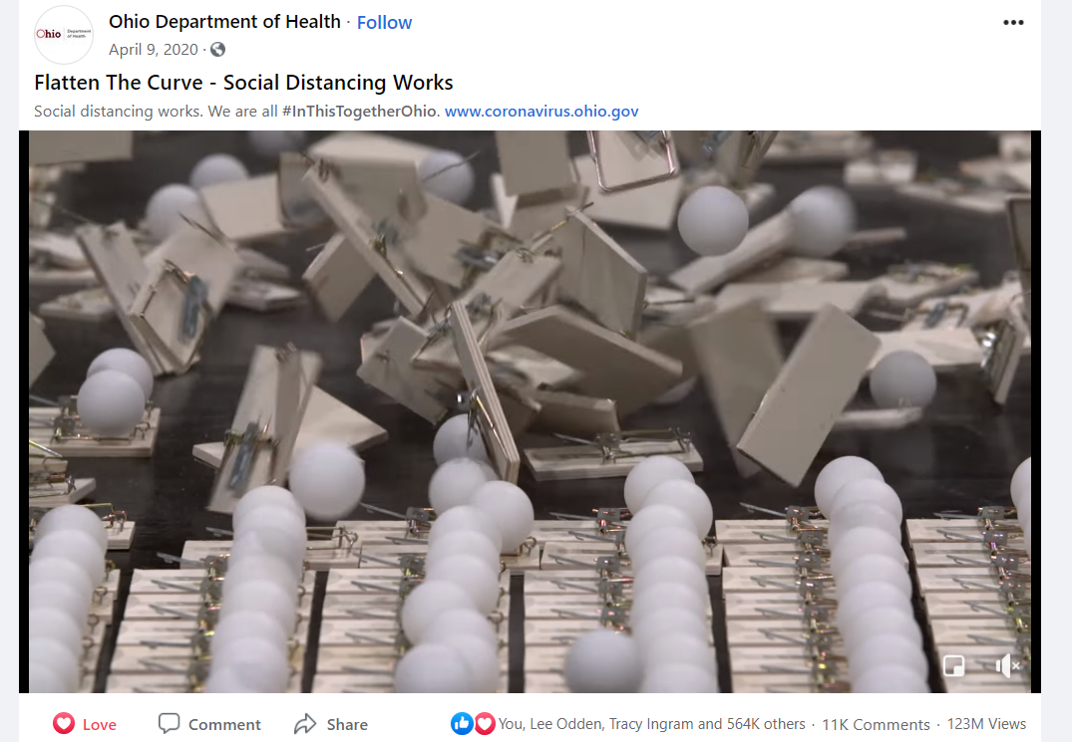
On May 22, 2020, Jordy Wilson uploaded Wind wave to his outdoorkindaguy account on TikTok. Featuring "Lose Control" by Meduza, Becky Hill, and Goodboys, the viral video got 27.8 million likes.
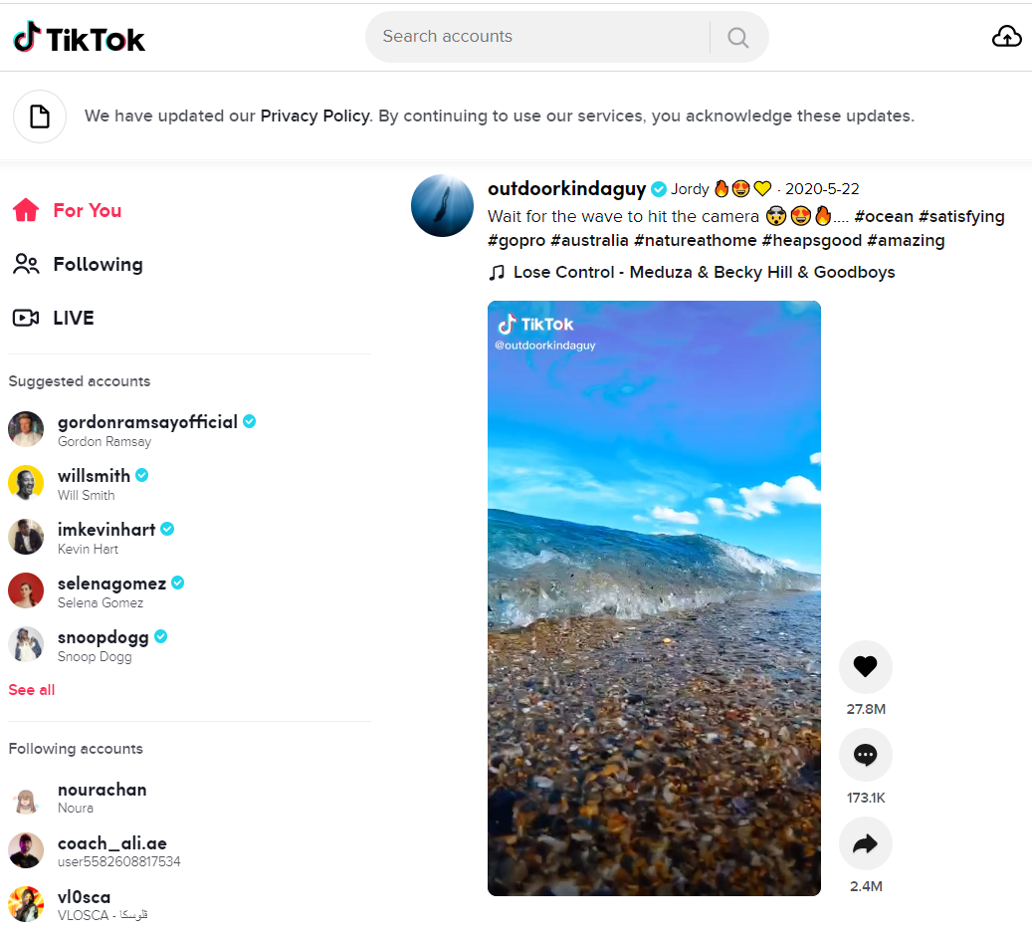
As I mentioned in my post, Top-Trending 2020 YouTube Videos Demonstrate Longer Is Stronger, the average length of the top-trending YouTube videos was 18:33 last year and the median length was between 15:43 and 17:13.
So, short-form videos may be the bright shiny object, but don't count out longer-form content.
In fact, the #2 top-trending video last year, Backyard Squirrel Maze 1.0- Ninja Warrior Course, was 21:39 long.
The description says, "Squirrels were stealing my birdseed so I solved the problem with mechanical engineering :)"
Uploaded to Mark Rober's channel on YouTube on May 24, 2020, this educational video has 76.8 million views and 2.4 million engagements.
Year 16: May 29, 2020 to May 28, 2021
It's worth noting that the top-trending 2020 video, 8:46 – Dave Chappelle, was 27:20 long.
Chappelle says in the video's description, "Normally I wouldn't show you something so unrefined, I hope you understand."
This is not a special but rather an impromptu purging of feelings and thoughts delivered by Chappelle during his show in Ohio on June 6, 2020, shortly after George Floyd's death.
Uploaded to Chappelle's Netflix is a Joke channel on YouTube June 11, 2020, this enlightening video has 30.3 million views and 997,000 engagements.
Meanwhile, Bella Poarch officially created the most-liked video on TikTok in August 2020.
Her lip-syncing video, Bella does M to the B, got a whopping 50 million likes for simply bopping her head to "Soph Aspin Send" by Millie B.
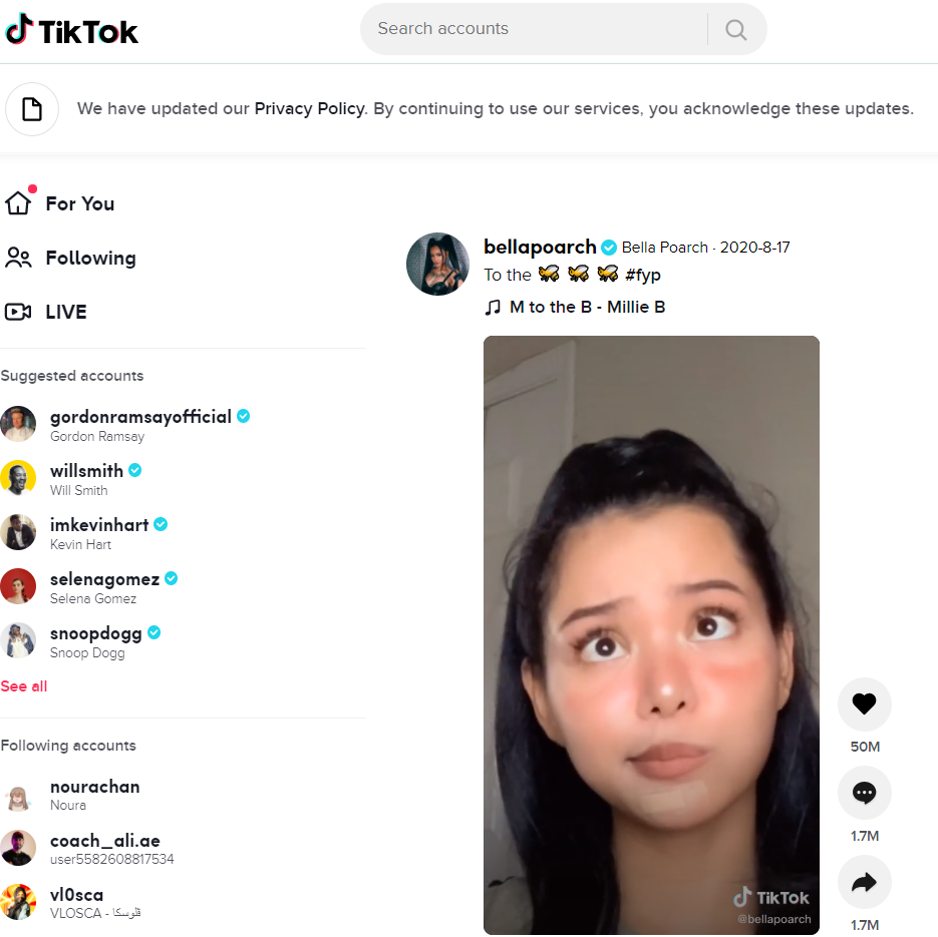
Of course, prank videos like SHE WAS SUNBATHING 🤣 (PARODY), continue to be popular, year in and year out.
Uploaded by Julius Dein to Facebook on Dec. 16, 2020, this video is 3:17 long. And it got 733 million views and 4.1 million engagements.
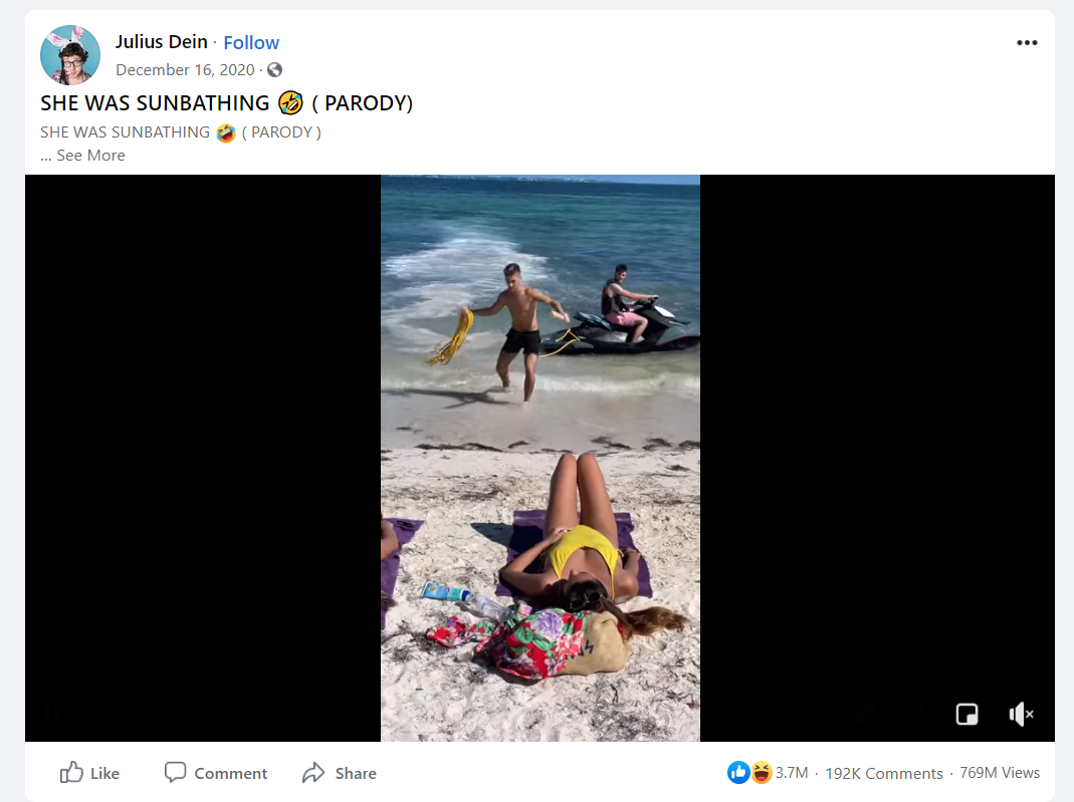
What Lessons Can You Learn From the Top 40 Viral Videos of All Time?
So, what valuable lessons can content creators and video marketers take away from examining the videos that have gone viral over the past couple of years?
Many of the key trends were spotted in July 2019 by the Google/Insight Strategy Group, which asked 12,000 people worldwide what they had watched in the last 24 hours.
Their answers were reported in an interactive feature on Think with Google entitled, What the world watched in a day.
The participants, ages 13 to 64, watched a wide variety of content, ranging from traditional media to online video.
This included YouTube (78%), Subscription VOD (45%), Facebook (43%), cable TV (39%), Instagram (33%), satellite TV (28%), network websites (28%), and Snapchat (12%).
The survey asked people to choose their No. 1 reason to watch from a list of 20 reasons and found the following results:
- Helps me relax and unwind.
- Teaches me something new.
- Allows me to dig deeper into my interests.
- Makes me laugh.
- Relates to my passions.
- Is inspiring.
- Makes me forget about the world around me.
- Keeps me in-the-know.
- Addresses social issues that are important to me.
- Has high production quality.
- Helps me be efficient.
- Is on a network or platform I like.
- Is easy to watch on-the-go.
- Doesn't require my full attention.
- Reminds me of my life.
- Takes me back to another time in my life.
- Has its finger on the pulse of culture.
- Created by people like me.
- Makes me feel part of a community.
- Has famous actors.
Right there, you have a long list of ways that a video's content can tap into your target audience's personal interests and passions before you get to the network or platform that it's on.
In other words, content is still King. The platform is – at best – a Baron.
In fact, the ability to help people dig into their interests was twice as important as being on a preferred network or platform. And it was four times more important than featuring famous actors.
So, yes, trends in the digital video marketing business generally don't move in a straight line. Some tendencies and fashions change. Other movements and things don't. And still, other developments and crazes unexpectedly move sideways.
But, if there is one over-arching lesson can you learn from reviewing the top 40 viral videos of all time, then it is: Create content worth sharing.
Yes, you can upload it to different platforms.
Yes, you can make it in longer or shorter formats.
And, yes, your audience may watch it on a variety of different devices.
If you want lots of people to help your video go viral by sharing it with all of their friends, family, and colleagues, then create content that helps them relax and unwind, teaches them something new, allows them to dig deeper into their interests, makes them laugh, relates to their passions, is inspiring, makes them forget about the world around them, keeps them in-the-know, or addresses social issues that are important to them.
In short, two-thirds of what makes a video go viral is content that speaks to what they're passionate about. Only one-third is the platform that they prefer.
Now, that's a valuable lesson that's worth learning, whether you're a content creator or a video marketer.
More Resources:
- 7 Reasons Why Content Needs Amazing Images, Videos & Visuals
- 18 Must-See Video Marketing Secrets & Insights
- YouTube News, Plus Trends, Techniques, and Guidelines
Image Credits
All screenshots taken by author, June 2021
SHOW COMMENTS
Source: https://www.searchenginejournal.com/top-viral-videos-all-time/302343/
0 Response to "Funny Viral Videos for Week of October 2018"
Post a Comment